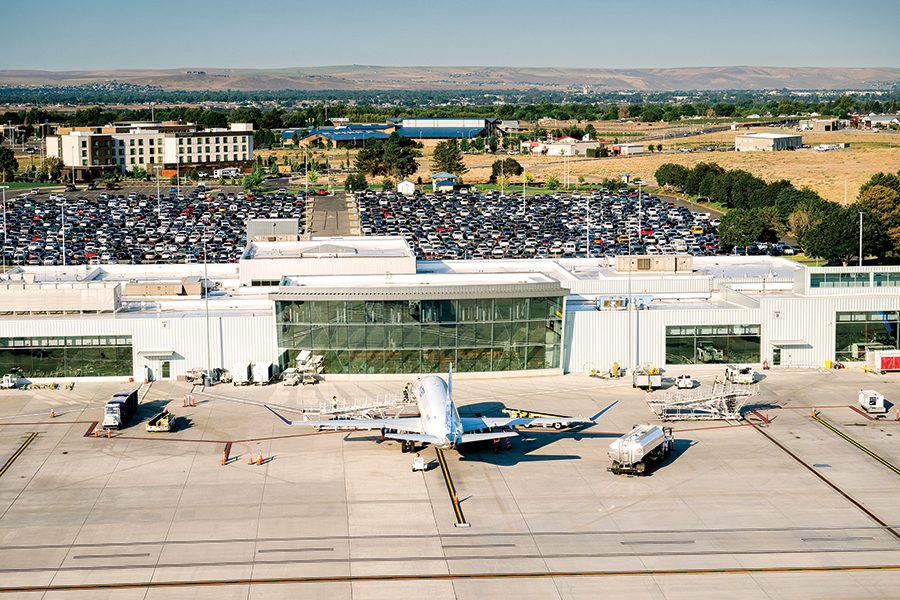
Home » Port of Pasco: Tri-Cities Airport soars toward record-breaking passenger levels
Port of Pasco: Tri-Cities Airport soars toward record-breaking passenger levels

October 11, 2023
Earth continues to move across Port of Pasco properties as the port-owned Tri-Cities Airport steadily returns to pre-pandemic travel levels.
The port is at 100% capacity at its Pasco Industrial Center (PIC 395) and nearing capacity at the Reimann Industrial Center and needs to buy more land.
Tri-Cities Airport
Randy Hayden, the port’s executive director, said June 2023 marked the first month since the pandemic that the airport surpassed its record-year of deplanements, or the number of people arriving, in 2019.
June 2023 saw 40,162 de-planements while 2019 recorded 39,711 total.
He said that though the year-to-date numbers were lagging behind 2019 numbers, “we do expect that this year will be the highest numbers in passengers.”
Hayden said he hopes this and promising load factor numbers will continue to attract more new flights and airlines to PSC. This metric measures the percentage of available seating capacity filled with passengers.
In 2022, flights out of Pasco were over 90% full, higher than that of any other airport in the Pacific Northwest, he said, with most of the airlines tracking in the high 80% range.
“If you’re around the low 80%, that’s considered pretty good. So low 90% is great for airlines and marketing, though not so great for passengers,” he said.
It’s a conundrum, because while load factors have been high at PSC, despite a steady increase in the regional population and corresponding uptick in passenger counts, Hayden said the share of the population flying out of Tri-Cities Airport is decreasing.
“If you go back to 2015 or 2017, about 40% of passengers still flew out of Pasco. Last year it was 32%,” Hayden said. “People are driving to Seattle, mostly because they can’t get the flight they need … If more seats were available here, more people would stay to fly out of Pasco.”
This is another factor airlines consider when looking at adding them and servicing new airports.
A nationwide pilot shortage also plays a role, especially with smaller aircraft like those departing PSC. To maintain service, some airlines flying out of Tri-Cities have traded their smaller aircraft for larger ones, which offer more seats per flight, allowing the airlines to condense their flights without sacrificing passenger counts.
Hayden is hopeful that a Dallas-Fort Worth direct flight will still materialize with the addition of American Airlines’ new direct flight to Phoenix. Dallas-Fort Worth is one of American Airlines’ hubs.
One incentive to attract new routes is to subsidize them for the first year they operate with the help of a $750,000 federal grant. The funding allows airlines to offset the cost-to-profit deficit to operate flights until the new route becomes more established and self-sufficient.
Despite current challenges, Hayden is optimistic. “There are a lot of airports that have not come back from the pandemic and that have lost airlines, so we feel fortunate to be on the side of gaining new routes,” he said.
On the facilities side, Buck Taft, Tri-Cities Airport director, said the port is currently in the design phase for expansion of the baggage makeup area, the non-public space where baggage is sorted.
“(It’s) currently too small to handle the larger aircraft and additional aircraft we now have,” he said.
Three additional jet bridges at some gates also are being designed so passengers no longer have to walk across the tarmac to board their plane.
Improvements to taxiway G are now completed, opening future aeronautical development areas while at the same time improving the safety of general aviation activity.
Taft said this year the port will shift PSC’s north-south runway approximately 300 feet to the north and replace some pavement on the general aviation apron, in addition to adding on for future development.
Airport area developments
This ties in with activity at the Airport Business Center where soon Rickenbacker Drive will be connected to Varney Lane to the east, which is predicted to drive additional interest in the airport-accessible properties along Argent Road.
Though a previous deal with Solgen Power didn’t pan out, Hayden said other developments are in the works.
Most notably, Musser Bros. Inc. has been developing the corner of Morasch Lane and Rickenbacker Drive to build a new home for its Estate Details arm, an auto detail shop that will serve both Trucks and Auto and the public, as well as a couple of additional commercial tenants.
Another airport-anchored business development the port is working on master planning is an Aerospace Innovation and Manufacturing Center on 460 acres of infield land adjacent to the runways with the help of a $416,000 grant from the state Department of Commerce.
“Aerospace is rapidly evolving, including advancements in electric and hydrogen-powered aircraft, private space exploration, vertical take-off and landing vehicles, autonomous flight systems and uncrewed aerial vehicles. Modern aerospace companies are developing impressive new technologies for civil, commercial and military markets. The right projects will be very successful in Pasco,” said Hayden in the port’s spring newsletter.
Industrial land at capacity
In stark contrast to low occupancy rates at port industrial facilities just a few years ago, Hayden said that the Port of Pasco is at 100% capacity at its Pasco Industrial Center (PIC 395) and nearing capacity at the Reimann Industrial Center.
United Parcel Service (UPS) bought 11 of the remaining acres, while 17 acres are under contract with Old Dominion Freight Line Inc. and another 25 acres with APG Land Acquisitions, a logistics provider.

As progress continues on Darigold’s new milk dehydration plant, the port is actively talking with potential tenants for the remaining 150 acres at Reimann.
“We’re out for new land,” Hayden said, adding that the port hopes to acquire land in the vicinity of Darigold so it can use the infrastructure already extended there to service the site.
Osprey Pointe
On the waterfront, the master planned transformation of Osprey Pointe into a vibrant mixed-use development is moving forward.
The port approved JMS Construction’s master development agreement on Aug. 9, allowing the contractor to move forward with the first phase of the project, two four-story mixed-use buildings which will feature three stories of apartments with commercial space on the ground floor.
A detached townhome development featuring two-story condominiums is also in the works.
JMS announced in September 2023 that it signed franchise agreements for two hotels, Wyndham and Wyndham Garden.
The long dreamed of marketplace is still on the development schedule but further down the list of priorities, as the developer continues to work on a cost-effective way to proceed with the project in light of new state energy codes.
The master development agreement approved by the Port of Pasco includes 24 separate projects scheduled to be completed in 2036.
The Port of Pasco’s 2023 operating budget is $23.6 million and its capital budget $46.7 million. Income from property taxes totals $2.7 million.
Construction + Real Estate
KEYWORDS october 2023





